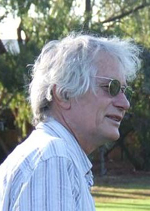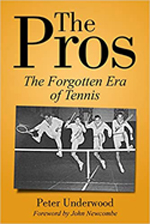Rod Laver:
Part 2
Peter Underwood

Besides his exceptional ball sense (Click Here for Part 1), Rod Laver's first coach Charlie Hollis saw 3 additional attributes in the young player. First, Rod was left-handed. Second, he was inexhaustible. Third, he was innately calm.
In those times, the kid's left handedness was a challenge to the coach. Being left handed made you a "mollydooker," a derisive term indicating inherent deficiency, so much so that Australian children were at the time forced to learn to write with their right hands.
The Flaw
Charlie Hollis had studied the line of great champions. He believed that the game of every left handed champion of the past was flawed. Yes, their penchant for spin and swerve, along with their relative rarity, gave them advantages over most opponents. But their apparently immutable preference for the left side invariably produced a distortion.
They may well have loved crunching a swinging forehand wide from their natural left, but when they were pressed on the right, the backhand was usually little more than a cramped and defensive slice.
Unlike Robert Rosewall, who forced his naturally left handed son Ken to play right handed, Charlie Hollis decided his new pupil was going to remain a left-hander. But also that he would possess a real backhand.
Backhand Model
Charlie himself possessed a freewheeling attacking backhand and this was the boy's model. Young Rod was taught that the movement of a proper backhand stroke was a liberated arc.

From a side-on position, with shoulders fully turned, the arm would then be freed, straightening as the body unwound through the stroke. The path of the swing was low enough at the beginning and high enough at the end to produce controlling topspin, and the finish was a full and triumphant followthrough.
Hollis's repeated cry of "Hit through the ball" became the mantra. On pain of the coach's severe displeasure, Rod's original backhand, the left-hander's pokey jab with elbow up and pointed, was banned from the first moment.
It helped that Rod's first year in school coincided with a change in Australian education. Children who preferred to write with their left hand were allowed to do so. Hollis' 10 year old pupil was to be a balanced and attacking left-hander.
But the young Laver held two other natural advantages. Yes, his backhand provided the balance to offset the lefties' weaknesses.
But Hollis had also begun sizing up the mental capacity hiding behind the meek exterior of his latest charge. And the flamboyant coach was soon announcing his conclusion. It was Rodney, not his brothers Trevor or Bob, who would end up at Wimbledon.
"He's got his mother's manner," said the coach to father Roy, "easy going --not quick-tempered like the boys or us."
5AM

Furthermore he was tireless. To get in some practice before their morning lesson starting at 6.30, the boys would get up at 5.00 am and ride their bikes the five miles to the town courts where Charlie held his lessons, arriving while Hollis was still asleep. Being the smallest, Rod was the one dispatched to fetch the balls, securely stashed under Charlie's bed in his hotel room. Laver balanced his left handed game with an incredible topspin backhand.
In the dark Rod would creep in and, stealing under the bed of the sleeping coach, try to collect the balls without waking him. Joined by Charlie, after he took his breakfast in the hotel dining room, the eager students filled in the hours of each day before school.
Hollis's method was based on drills, which began without the ball and were repeated until ingrained. The boys would have to simulate 100 backhands, then hit 100 backhands. Then, after modelling 50 serves, it would be time to hit 50 serves, rapid fire for 10 minutes into the wire around the court. By the time they left for school their arms felt ready to drop off.
To keep the interest of his pupils, the coach would also draw them in for talks about the game. Here they learned its rules, as well as the lore of the great players and the famous arenas in which they performed.
Tennis was not all that Hollis taught. Though he might choose to live alone in a none-too-swanky country boozer, Charlie Hollis liked it to be known that he had moved amongst the better classes.
Manners
On one occasion when Charlie came to dine with the Lavers, he observed that the lad was wolfing down his food. Turning to the boy who had become his pupil, Hollis observed sharply, "That, Rodney, is not the way to hold a fork. If you are to play at Wimbledon, you must learn to eat properly, not like a savage." With elan, he would then demonstrate what was acceptable in the way of table manners.

There were social activities apart from tennis. The boys swam, went bush hiking, and even hunted kangaroos. They were keen on fishing too, and took out a small boat in search of the sea life that abounds in the tropical ocean off the coast at Rockhampton.
As a family friend, sometimes Charlie came along. Though he enjoyed the occasions, it seemed this singular man could never be free from his obsession with the game he loved. One day when young Rod excitedly showed the coach a beauty he had just reeled in, Charlie only remarked, "You know, that Fred Perry surely had one marvelous forehand."
Hollis's stories of great champions were revered and internalized by the eager pupil--so much so that when Laver was introduced to Ellsworth Vines, to the older man's bafflement he blurted out, "But I know you already."
And when Laver eventually observed Don Budge hit a backhand, the stroke appeared entirely familiar--at his master's knee, he'd already seen it. Hence the boy knew a great lineage. Soon, his only desire was to join it.

As he candidly informed those closest to him, Charlie thought that his own game had been close to the top. But Hollis had never made it past the last 16 of any of the bigger tournaments. From his experience, he realized that the highest achievement requires the combination of superlative and reliable technique with equally superlative and reliable fitness, both physical and mental.
Two Other Aspects
Doubtless, he wanted such achievement for his young charge. What happened next in the subsequent evolution of Rod Laver might be best analyzed by isolating two aspects of the lad's developing game: spin and personality.
Hollis loved topspin. But as Charlie studied the young lad, it dawned that spin could be more than he'd ever envisaged. And this is where the matter of grips again enters the picture.
Since Hollis had started young Rodney with the backhand, he'd insisted on the proper grip as the basis of the stroke. After laying down the rudiments of a free-swinging backhand, the pair progressed to the southpaw's natural left side, and the forehand.
To what must have been Hollis's surprise, when the youngster hit forehands, he began to resist his coach's preferred grip. This was the Eastern.
But no! The boy was hitting the forehand with just about the same grip he used for his backhand: the Continental, with the palm more on top of the handle. Yet the result seemed lovely, with the reach, quickness and whip characteristic of the Continental style.

Hollis deliberated. After a while, he concluded that the stroke looked so sweet that changing it would be a crime. So, early on, the youngster got to keep his Continental grip.
At first, Charlie's emphasis on spin was merely an extension of the orthodox idea of spin as control. Charlie would tell the boy that the only way a player of his size could belt the ball was by hitting it with a lot of topspin.
Make It Spin
All of this seemed natural to young Rod. From the first he loved to "make it spin." This ability to blend power with topspin never left him.
In anyone else, such a departure from the tried and true Tilden method --racket through the ball with wrist locked --would have spelled instability, if not disaster.
This didn't happen to Laver for two reasons. First, he made his wrist the size of most people's forearm, and his forearm the size of their leg. At maturity, Laver's arm dangled from a slight frame standing at just over 5 feet 8 inches and weighing 147 pounds. But his massive forearm measured 12 inches around the same size as the forearm of the champion boxer at the time, the powerful middleweight Rocky Marciano.
The second buffer against instability in his strokes was his temperament: this allowed him to practice so hard and long that the complex pattern became grooved in his nervous system - soon it flowed like clockwork.
If technique in the form of outrageous spin became the first of the two aspects making up the exotic Laver style, the second was personality.

Although this earnest lad was blessed with a temperament so equable as to appear almost drab, he loved nothing more than the sound of the smack of racket on ball . "Yes, I love to give the ball a nudge," admitted the understating Laver. But there was something beyond power that turned him on. It could be designated, the fiendish.
Wicked spins, uncanny angles, and shots conjured from nowhere, these were what made the game such an entrancing and endless celebration. And these paid for the physical strain, the lonely toil and the endless practice that made up his life as a touring athlete.Further, he realized the strokes they were forging demanded exceptional fitness and strength. As a result, Hollis steadily intensified his program of physical conditioning. Besides running and exercises to build up stamina and speed, they worked on strength, particularly in chest and arm. And to build up the wrist, he urged the kid to squeeze a squash ball in his spare time.
The result was that the once-scrawny youngster was to become one of the most feared fifth set opponents in the history of the game. A gifted boy had fallen under the sway of a great teacher.





